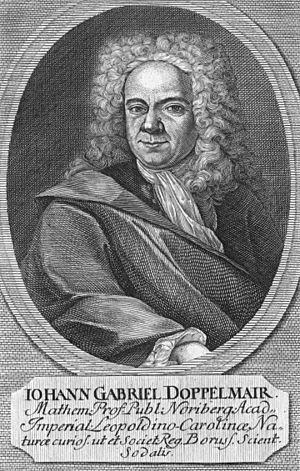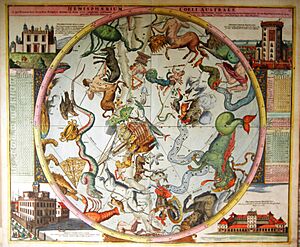Johann Gabriel Doppelmayr facts for kids
Johann Gabriel Doppelmayr (born September 27, 1677 – died December 1, 1750) was a smart German man. He was a mathematician, an astronomer, and a cartographer. This means he studied numbers, stars, and made maps. You might also see his name spelled Doppelmayer or Doppelmair.
Contents
His Life and Work
Early Life and Education
Johann Gabriel Doppelmayr was born in Nuremberg, Germany. His father, Johann Siegmund Doppelmayr, was a merchant. Johann Gabriel started school in Nuremberg in 1689.
Later, in 1696, he went to the University of Altdorf. There, he studied mathematics, physics, and law. He continued his studies in Halle and finished in 1698. His final paper was about the Sun.
Travels and Learning
While studying at the University of Halle, he also learned French and Italian. He decided not to become a lawyer. Instead, he spent two years traveling. He visited places in Germany, Holland, and England. He spent time in cities like Utrecht, Leiden, Oxford, and London. During his travels, he learned to speak French, Italian, and English.
He kept studying astronomy. He even learned how to grind and shape his own telescope lenses. This helped him see the stars better.
A Professor and Mapmaker
In 1704, Doppelmayr became a professor of mathematics. He taught at the Aegidien-Gymnasium in Nuremberg until he passed away. He wasn't famous for making big new discoveries. However, he published many scientific books.
His books covered topics in mathematics and astronomy. He wrote about sundials, which tell time using the sun. He also wrote about spherical trigonometry, a type of math used for curved surfaces. He made many maps and globes of the sky. One of his books also had helpful information about hundreds of mathematicians and people who made instruments in Nuremberg.
His Famous Star Atlas
Doppelmayr worked closely with Johann Batist Homann. Homann was a Dominican friar and a famous map publisher. In the early 1700s, Doppelmayr created many astronomy pictures for Homann's map books.
In 1742, these pictures were put together into a book called Atlas Coelestis in quo Mundus Spectabilis.... This atlas had 30 plates, which are like large printed pages. Twenty of these plates showed astronomy topics and how they developed over time. They included ideas from Copernicus and Tycho Brahe about the universe. They also showed how planets move and details of the Moon's surface. These details were seen using new telescopes.
The other ten plates were actual star charts. They showed the stars in the northern and southern parts of the sky. Two other plates showed stars as if you were looking at them from outside Earth. These plates also featured pictures of European observatories. Doppelmayr had visited these places during his travels.
His Family and Memberships
Johann Gabriel Doppelmayr married Susanna Maria Kellner in 1716. They had four children, but only one survived.
Doppelmayr became a member of several important scientific groups. He joined the Berlin Academy. In 1733, he became a member of the Royal Society in London. In 1740, he joined the St. Petersburg Academy of Sciences.
How He Is Remembered
Doppelmayr is remembered in space! A crater on the Moon is named after him. It is called Doppelmayer. Johann Hieronymus Schröter named it in 1791. Also, a small planet, 12622 Doppelmayr, is named in his honor.



